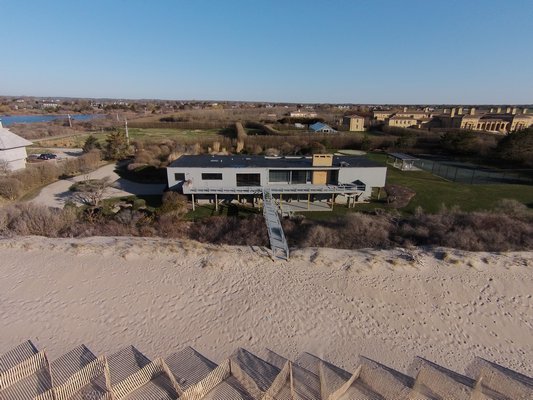
An effort to save a Sagaponack house designed by renowned architect Philip Johnson has apparently fallen short, dooming the house to demolition this month.
The house, known as the Farney House after its original owners, is seen as a precursor to Johnson’s celebrated design known as the “Glass House” in New Canaan, Connecticut. When the Sagaponack house sold for $24 million last year and the new owners proposed demolishing the structure, which has been extensively updated and expanded from its original design, some in the architectural community lamented its coming loss. An effort was made to find a new owner with an eye for modernist architecture who would be willing to fund the moving of the Farney House off the Fairfield Lane property where it was built in 1945.
As recently as July, two individuals had been interested in taking the house, but the effort to work out a feasible relocation failed.
“I wouldn’t say it was too late, but given the logistics of what it takes to move a house, it is unlikely it can still happen,” architect Roger Seifter of Robert A.M. Stern Architects, the designers of the house slated to replace the Farney House, said last week. “As far as I know there were very few inquiries, one that I know of and I was told there was one other. The owner decided to put off the actual demolition until after the summer to give that attempt an opportunity.”
Mr. Seifter said that failing an eleventh-hour savior, the house will be taken apart “shortly after Labor Day.”
Members of the Sagaponack Village Architectural and Historic Review Board had lamented the proposed destruction of the house and had marshaled the effort to find an interested buyer. But the board was unable to find a legal avenue to preventing the demolition. Village codes can require the preservation of culturally significant structures or those designed by architects of great repute, but the extensive modifications made to the structure meant that its significance had been substantially diluted.
When originally built, the house was one of the first examples of the emerging modernism movement in architecture, of which Johnson was a pioneer and one of the most celebrated artisans. The Farney House was a sparse cottage by today’s standards: a simple one-level rectangle, less than 2,000 square feet, uninsulated and mounted on pilings, with no foundation. The modestly simple interior deferred to the stunning landscape of dunes and sea sprawled out before it.
The house was seen as a precursor to Johnson’s Glass House, which takes the same general shape as the Farney House, with the obvious distinction of its walls being entirely glass.
In a series of updates in the 1970s, 1980s and 1990s the Farney House was modernized, insulated and expanded. The existing structure is either 4,500 square feet or 9,000 square feet of winterized living space, depending on whether or not a finished above-ground basement is included. It has eight bedrooms, seven marble-floored baths and a sweeping modern kitchen.
Nonetheless, most of the architectural details of the original remain, inside and out, and architecture aficionados had foreseen the modern additions being stripped away and the original being restored, even if in a new location. Others had noted that taken out of its original setting, the importance of Johnson’s vision was diminished greatly.
Mr. Seifter said that one remaining feature of the original structure may still be salvageable. The distinctive cedar paneling still lines the walls of the main living room and Mr. Seifter said it could be removed before the house is torn down.
“It wouldn’t take much effort to do that and I think it would be worthwhile,” he said. “That is one thing ... it is Johnson’s paneling.”